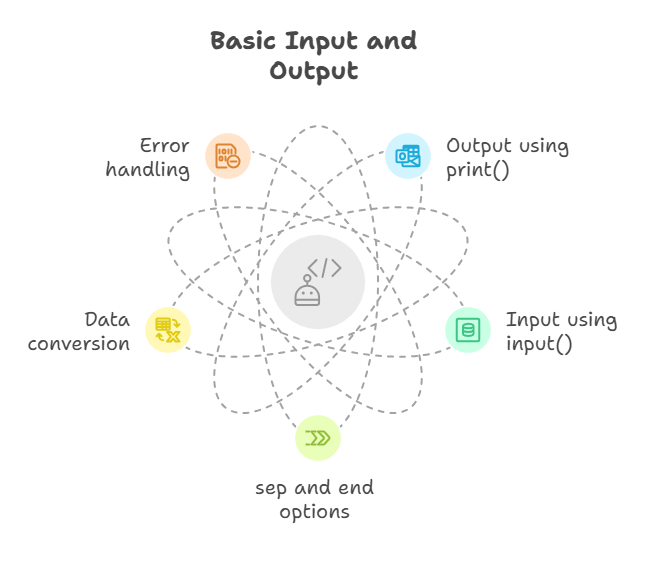Basic Input and Output Of Python

Python programming requires basic input and output (I/O) concepts to communicate with users and display data. A program takes input, processes it, and outputs the results. Programs communicate with the “outside world” through input and output. Python’s print() and input() methods are the main tools for simple text-based input and output. Basic Input and Output Of Python.
Basic Input and Output Of Python Programming entails receiving information, processing it, and generating output, as was previously mentioned. Python’s built-in print() function for output and input() function for input are the main methods for managing this interaction in text-based console programs.
Output using print()
The output is shown to the user using the print() method. A program’s output is the data or outcome it produces. A variety of values, including strings, numbers, and values stored in variables, can be printed.
Here are a few instances of print() in Output :
# Printing a string literal
print("Hello, World!") # [10, 13-15]
# Printing a number
print(47) # [8]
# Printing the result of an expression
print(8 * 9) # [8]
print(5 + 3) # [16]
# Printing the value of a variable
message = "Learning Python is fun!" # [9, 17]
print(message) # [17]
# Printing multiple values
print("The answer is:", 42) [2]
Print() inserts a newline character at the end and uses a space to separate multiple numbers by default. With the use of the sep and end options, you can alter this behaviour.
- The separator between several values can be changed using the sep option.
- The end option modifies the output’s final line, which is by default a newline.
Example using sep and end:
#Using sep to change the separator
print("555", "0123", sep="-") # Output: 555-0123 [18, 21]
#Using end to print on the same line
print("Hello", end="") # [18, 21]
print(" world!") # Output: Hello world! [18, 21]Input using input()
To get user input, utilise the input() function. The application pauses and waits for the user to type anything and hit Enter when input() is called Basic Input and Output Of Python. Even if the user enters a number, the input() function always yields a string. This is important since you must turn input into a number for calculations in Basic Input and Output Of Python for Float() and int() can be used for this conversion.
It is optional to provide a string prompt message inside input()’s parentheses. The user is presented with this prompt to instruct them on what data to provide.
Get input and store it in a variable using the following basic structure: variable name = input(message to user).
Here are some examples of using input():
# Getting simple text input
name = input('Enter your name: ') # [1, 22, 28, 36]
print('Hello, ', name) # [22]
# Example interaction:
# Enter your name: John [37, 38]
# Hello, John [37]
# Getting numerical input (requires conversion)
num_str = input('Enter a number: ') # [22, 34, 39]
# num_str is a string here, e.g., "7"
num = int(num_str) # Convert the string to an integer [22, 24, 30, 32, 33, 35]
print('Your number squared:', num * num) # [22]
# Example interaction:
# Enter a number: 7 [40, 41]
# Your number squared: 49An error will occur if the user enters non-numeric content when you anticipate a number and use int() or float(). Later in your learning process, you may need to use error-handling strategies like try-except blocks to deal with this.
Because they enable programs to be interactive, receive user data, and display results, input and output functions are crucial. To create interactive applications that can display results and receive data from the user, basic input and output using print() and input() are necessary. There are other types in Basic Input and Output Of Python, such reading from and writing to files, which enable persistent data storage, even though these methods manage normal console interface (usually the keyboard and screen, known technically as standard input and standard output).
